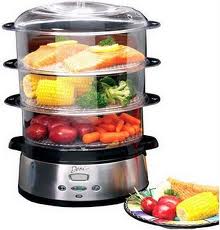Preparing vegetables using the moist-heat
Cooking by simmering
Vegetables should not be boiled, but instead simmered in as little water as possible to avoid nutrient loss and adverse effects on flavor, texture, and color. To simmer, vegetables (with the exception of potatoes) are added to lightly salted boiling water; when the water starts to return to a boil, the heat is immediately lowered to a simmer, and the vegetables are cooked until tender. Mushy textures result from overcooking vegetables or boiling them heavily so they bounce against each other. During simmering, the lid may be left off to allow volatile acids to escape, but leaving it on reduces the heating time. Approximate times for cooking vegetables vary from 5 to 30 minutes, with beets exceeding this general time frame by taking about 30 to 40 minutes for young beets and up to 2 hours for older beets.
 Potatoes (peeled or unpeeled) are always started in cold salted water, brought to a boil, and lowered to a simmer. Waxy potatoes such as Round Reds have less starch than others and are more suited for simmering. Their higher moisture content and better ability to hold their shape make them appropriate for such dishes as potato salad, soups, casseroles, and scalloped potatoes.
Potatoes (peeled or unpeeled) are always started in cold salted water, brought to a boil, and lowered to a simmer. Waxy potatoes such as Round Reds have less starch than others and are more suited for simmering. Their higher moisture content and better ability to hold their shape make them appropriate for such dishes as potato salad, soups, casseroles, and scalloped potatoes.
Simmered vegetables may be served pureed or prepared as baby food. Young, tender vegetables are thoroughly scrubbed, cooked, and pureed. The pureed mixture is then heated to the boiling point, cooled, and served.
Steaming Vegetables
Steaming takes a little longer than simmering (about 5 to 10 minutes more), but provides better retention of flavor, texture, and color. For steaming, vegetables are placed in a perforated basket inserted in a pan just above simmering water and cooked, tightly sealed, until just tender. Pressure cookers are not recommended, because their high temperatures make vegetables mushy; legumes such as pinto beans are the exception to this.
Microwaving Vegetables
One of the best ways to retain a vegetable’s texture, color, and nutrient content is to cook it in a microwave oven, since this method requires very little water and is fast enough to minimize loss of quality. Manufacturer’s instructions should be followed for the specific vegetable being prepared, but general guidelines for microwaving vegetables include adding a minimal amount of water, covering with plastic wrap, and microwaving for about 3 to 10 minutes (rotate or rearrange at half time) until fork tender.
Frozen vegetables may be cooked in the microwave oven without adding water, because water is already present. Canned vegetables are already cooked and need only to be reheated in the canning liquid and then drained. Home-canned vegetables low in acid concentration (above pH 4.6) such as green beans should not be microwaved, but rather boiled for 10 minutes-to prevent possible foodborne illness from botulism.
